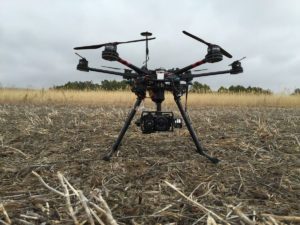
Researchers at Kansas State University hope drones can work their aerial magic to yield a better wheat harvest and are betting almost $1 million they can.
The National Institute of Food and Agriculture awarded $975,000 to the school’s Agricultural Experiment Station and Cooperative Extension Service to design a program which will allow agricultural scientists to dig deeper into in-field conditions and improve wheat-breeding programs.
The research program is part of KSU’s efforts to encourage more drone-data analysis in agriculture with projects already underway in Mexico and India.
“Perhaps the greatest bottleneck currently in plant breeding and genetics is effectively generating precision measurements of plant characteristics in the field,” project director and agronomy professor Jesse Poland said in a KSU press release.
“The goal of this project is to deliver in-season yield predictions by building models that combine genetic information from DNA sequencing and crop physiology that we will gather from UAV measurements on tens of thousands of breeding lines,” Poland added.
The program will deploy quadcopter drones to evaluate large swathes of wheat fields and, using millions of collected images, build a database to be used by crop breeders in the development of optimal wheat yields.
“Plant breeding is really a numbers game,” Poland said. “If we can use new technologies like remote sensing with these low-cost UAVs, then we provide the breeders with the tools to look through many more candidate varieties and increase the chances of finding ones that are really excellent and can become the next best varieties to release to farmers.”
Drone innovation has blossomed across Kansas over the past several years. State officials hosted a UAS Summit at the National Center for Aviation Training Wichita in 2015. The event allowed lawmakers, researchers and drone firms to connect and included exhibitor displays, training sessions and mission demos.
In December, Kansas utility Westar Energy announced the launch of a drone program to inspect rural power lines for breakage and damage. In 2013, the company collaborated with Kansas State University-Salina to establish a drone research program. Two years later, the partnership created the UAS pavilion, one of the largest enclosed drone flight facilities in the U.S. – 300-feet-long by 200-feet-wide and 50-feet-tall.
According to a report by AgFunder, drone agriculture investments grew by 237 percent from 2014 to 2015 and and the report added that “more growers are expected to use crop-scouting drones and various autonomous farm machines for data analysis and precision farming.”
Jason is a longstanding contributor to DroneLife with an avid interest in all things tech. He focuses on anti-drone technologies and the public safety sector; police, fire, and search and rescue.
Beginning his career as a journalist in 1996, Jason has since written and edited thousands of engaging news articles, blog posts, press releases and online content.
Email Jason
TWITTER:@JasonPReagan
Subscribe to DroneLife here.